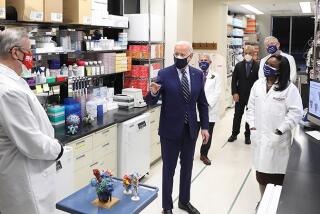Scripps Diagnostic Kit Aids Commercial Goal : Product for Detecting Mononucleosis Wins OK of FDA as Institute Seeks to Market Technology
- Share via
A federal drug agency’s approval last week of a mononucleosis diagnostic product developed at Scripps Clinic and Research Foundation is a sign that the transfer of technology from the Torrey Pines scientific stronghold to the marketplace may be accelerating.
Scripps officials said Monday that the Food and Drug Administration has given pharmaceutical giant Johnson & Johnson approval to sell Monolert, a diagnostic assay for infectious mononucleosis based on a patent held by Scripps. The so-called “kissing disease,” mononucleosis strikes an estimated 20% of all U.S. teen-agers.
Monolert will become the second product based on Scripps’ molecular engineering patents to reach the commercial market. The first was Monoclate, a synthetic blood coagulant for hemophiliacs introduced three months ago by Rorer Group, a drug company based in Fort Washington, Pa. Scripps expects to collect more than $200,000 in royalties from Monoclate in its first year of sales.
Revenue and Incentive
The new products are visible results of Scripps’ increased efforts to commercialize the technology developed by its 450 staff scientists, all of whom are M.D.s or Ph.D.s.
Scripps sees such commercialization both as a means of adding to its coffers and of preventing its scientists from leaving to start companies on their own.
Scripps gives at least 15% of its royalties from patented technology to the staff scientists who developed them, said Raymond Kahn, Scripps’ industrial liaison officer in charge of marketing Scripps technology.
$5-Million Market
Monolert, a “dipstick” kit using synthetic peptides on a patient’s blood serum, was developed by Scripps researchers John Vaughan, Dennis Carson, Gary Rhodes and Richard Houghton.
Sales of Monolert by Johnson & Johnson’s Ortho Pharmaceutical subsidiary to clinical and hospital laboratories will begin over the next month or two, said Elliot Parks, director of diagnostic programs at the Johnson & Johnson Biotechnology Center in San Diego. The J&J; laboratory was set up by the New Brunswick, N.J.-based company to facilitate its use of Scripps technology.
The market in dollars for one leading “mono” diagnostic kit last year was just $5 million--small potatoes for drug companies in J&J;’s league. But J&J; has hopes that Monolert will cause the diagnostic market to expand because of its longer shelf life and because it will give mononucleosis patients more-conclusive evidence that they don’t have hepatitis or leukemia, two diseases with symptoms similar to those of mononucleosis.
Gets First Crack
Johnson & Johnson licensed the Monolert technology under terms of a 6-year-old agreement whereby the pharmaceutical giant gets first crack at all commercial medical applications of technology developed at Scripps. PPG Industries of Pittsburgh has a similar pact involving all of Scripps technology with agricultural applications.
Several more Johnson & Johnson diagnostic products using Scripps technology are “in the pipeline” and may be given FDA approval this year, Parks said.
Johnson & Johnson and PPG each paid more than $10 million to Scripps to receive their privileged looks at its technological breakthroughs, Kahn said.
Won’t Be a Bonanza
Neither Scripps nor Johnson & Johnson, which posted $8 billion in sales last year, views the Monolert product as a bonanza. Still, Kahn said royalties from the diagnostic product will be a welcome addition to Scripps’ projected $63-million budget. Kahn declined to estimate how much those royalties may end up totaling.
Scripps received its first royalties for Monoclate last month, a $50,000 check from Rorer, Kahn said. Monoclate, the trade name for Purified Factor VIII, has been hailed as a safe way of giving hemophiliacs the blood coagulant they need without exposing them to the risk of AIDS or hepatitis through donated blood.
Monoclate was developed from technology by Scripps scientists Theodore Zimmermann and Carol Fulcher.
Many Scientists Left
In 1982, Congress established the right of nonprofit research foundations such as Scripps to patent their technology. Before then, patent rights to technology developed with government grants were unclear, a significant impediment for Scripps because 75% of its research funds come from government agencies such as the National Institutes of Health. Because of the confusion, many Scripps scientists with entrepreneurial bents left the institution to form companies on their own.
The 1982 law meant Scripps, which has been at the forefront of molecular biology and immunology research, was free to stake legal claims to its technology and to hold out a percentage of royalties to its staff as incentive.
If the key to commercialization of technology lies in patent protection, Scripps is in a strong position. When Kahn was hired in 1982, the institute held only eight patents, four of which had lapsed. Now Scripps has received or applied for more than 150 patents.
15 Patents Last Year
Last year, Scripps received 15 patents, the 10th-highest total among U.S. research institutions and first among non-university research establishments, Kahn said.
Michael Martorelli, a pharmaceutical analyst with Janney Montgomery Scott investment firm in Philadelphia, said the agreement between Johnson & Johnson and Scripps is not unusual among major drug companies.
“It gives them a window on the academic world,” Martorelli said, and a way of participating in long-term research trends. Drug companies’ in-house projects are more often directed at shorter-term efforts directly connected to specific products, he said.





